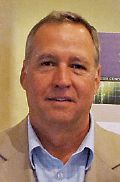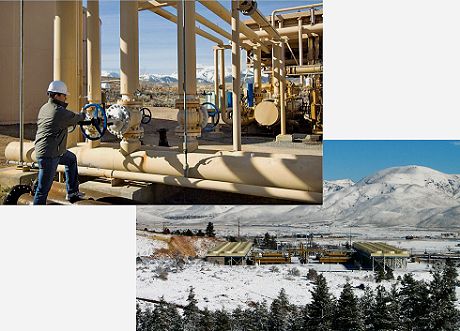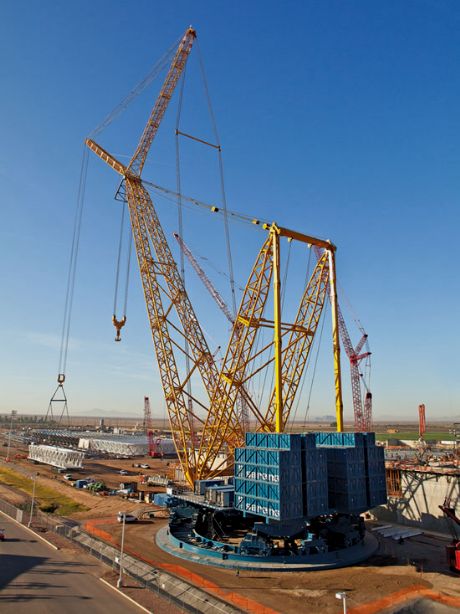What do an earthquake, a girl and the University of New Mexico have in common? In the case of Andy Lim, they all worked together to bring a young college graduate from Taiwan to Albuquerque about a dozen years ago.
Lim, an entrepreneur who founded Lavu Inc. to revolutionize the way restaurants process tableside orders, is a classic example of what happens when universities collaborate with communities to support economic development.
“We are going head to head against Silicon Valley and their hundreds of millions in capital,” says Lim, whose Albuquerque startup has grown from a kitchen table to a 26-person work force in about 6,000 sq. ft. (557 sq. m.) of space. “But we are staying in Albuquerque. We are very efficient here. The living costs are cheaper, and the Albuquerque government is a big help. Plus, we have been able to hire the best and the brightest locally. Many of them are still students at the University of New Mexico.”
Lim is, in many ways, indicative of an emerging trend in the U.S. Southwest — young, highly educated achievers taking novel ideas and using talent-rich college towns to grow their ideas into successful businesses.
Across New Mexico, Nevada and Arizona, entrepreneurs like Kim are tapping into this base of knowledge capital to propel their companies into rapid growth.
For Lim, the adversity of his homeland provided the impetus to move. Albuquerque provided the answer for where to go.
“I had just graduated from college in Taiwan when a magnitude 7.8 earthquake struck my country on September 21, 1999,” he recalls. “That was a very bad year in Taiwan. About 2,500 people died when buildings collapsed and other stuff happened. I needed a place to go.
“I chose Albuquerque and the University of New Mexico,” Lim says. “The reason was a girl. I was in love. So I moved here and found out that I had to retake a lot of classes. I chose MIS [management information systems] for my program. I did not know any English then either. I graduated from UNM in April of 2004.”
Lim worked for a law firm for a year before launching his own website design company. By mid-2010, Lim and a partner were working with a local restaurant owner who needed a better solution for taking and managing customers’ orders.
The result was Lavu — an iPad- and iPhone-based tableside ordering system that streamlines communications with the kitchen and overhauls back-office restaurant management. The system proved to be so innovative and ground-breaking that Gordon Ramsey even featured it on his popular TV show “Hell’s Kitchen.”
Advantage: Business Owner
“We are a small company but we think big,” says Lim. “We think of our customers as our friends. We want to make their lives a little easier. We want to help them make money and we want to help them in a cost-efficient way. It shouldn’t cost them a lot of money to have this better solution for their business. What we are really building is an ecosystem to help the business owner more effectively manage his or her business. No other point-of-sale system offers a flat rate like we do. A monthly fee of $39 for our system will be our model. We will stir up the industry.”
Lim is also fond of occasionally stirring up a professor’s classroom. “When our company was growing exceptionally fast, at one point I just had to walk into a class at UNM and ask, ‘Who wants to work?’ The teacher looked at me and said, ‘Who are you?’ I got one person out of that.”
And he’s not done. “We need three more programmers and three more support people right now,” Lim says. “Technology is growing very fast. We have to keep up.”
Colleges Fill Work-Force Needs
Gary Tonjes, president of Albuquerque Economic Development, says he sees companies like Lavu springing up virtually every day in New Mexico. “We have great, high-growth companies like Vitality Works, PolyFlo, Aspen Avionics and Ultramain Systems all thriving right here in Albuquerque,” he says.

Mark McCausland, president of Ultramain Systems, says his software development company frequently hires graduates from the University of New Mexico in Albuquerque and New Mexico Tech about an hour away in Socorro.
“We hire a lot of young kids right out of school. That is a nice resource for us,” he says. “There is a lot of high-tech work going on in this region, particularly since two of the three main national labs are based here at Sandia and Los Alamos.”
Ultramain’s primary industry is aviation. “We make the software that operates in the cockpit — electronic flight pads. Our software runs on those devices,” McCausland says. “We could be located virtually anywhere, but the attractions of Albuquerque are very compelling. We enjoy excellent airline connections out of here. This is one of the top 10 airports that is not a hub in the U.S. Getting in and out of here is much easier,” he adds. “Our customers are located all over the world. Airlines based in Hong Kong, Dubai, London and Amsterdam are our customers. I can catch a direct flight to these locations or can reach them with just one connection.”
Ultramain employs 100 workers now but will soon expand into a new 30,000-sq.-ft. (2,787-sq.-m.) building about a half mile from the company’s current location in Albuquerque.
“We like Albuquerque for other reasons as well,” says McCausland. “The traffic here is very easy. Another plus is the cost of living. The cost of operations is much less here. The weather here also is stellar, and the amenities are very good. It is a big enough town that you have all the cultural and social amenities that you would want.”
Support from economic development agencies played a pivotal role in the company’s latest expansion decision, he notes. “The state of New Mexico has a technology R&D tax credit that you get back from the state. It is a relatively new program in New Mexico,” McCausland says. “And that is what we do — high-tech R&D. That tax credit is very attractive to a technology company like ours.”
New Mexico also supplies the high-tech infrastructure that Ultramain needs, he adds. “There is very good fiber and Internet connectivity here,” McCausland says. “There are good computer science programs here. Nano-technology and plasma research are being done here. Microchip manufacturing is done here. This may not be Silicon Valley, but it is still a great location for technology companies.”
Close Relationship With ASU
That’s what Intel Corp. is saying about Chandler, Ariz. On August 14, the global microchip maker announced that it will build a $300-million R&D facility in the Phoenix suburb. The 285,000-sq.-ft. (26,477-sq.-m.) building will employ several hundred highly skilled workers.
This marks the second major construction project going on this year in Chandler for Intel. At the company’s Ocotillo campus in Chandler, Intel is building a $5.2-billion plant, Fab 42, to produce microchips. Completion is anticipated in 2013.
“The new space being added at these two sites is about 1 million square feet [92,900 sq. m.] total,” says Jason Bagley, spokesperson for Intel. “The new jobs to be added will be in the thousands. Our current work force in Chandler is more than 11,000 employees, plus a significant number of contingent workers and contract workers at both sites.”
Bagley says there are several location factors that are critical to Intel’s success. “The first decision point centers around the availability and cost of infrastructure to support a site,” he says. “When Fab 42 is completed, it will be the most sophisticated fab in the world for semiconductor manufacturing. A second critical factor is the work force. The highly skilled work force that we have in Arizona enables us to get our products to market faster.”
Bagley also cites the tax code. “How do state and local governments treat a capital-intensive business like Intel? Arizona has done a very good job of helping Intel address the barriers,” he says. “And the regulatory environment is key too. In order to be successful, Intel has to have the ability to move extremely fast. Regulations reduce speed. We constantly have to tweak our process to enable us to move very quickly. We have to be in environments where we have that speed to market.”
The local partnership with Arizona State University is the deal-closer for Intel, says Bagley.
“Intel hires more graduates out of ASU than we do from any other university in the country,” he notes. “That has been a key relationship for us. We are able to find bachelor-degree-level personnel here. The Chandler area work force is highly trained in terms of being able to work in a semiconductor manufacturing environment. They have a significant amount of skill and educational background. This highly skilled work force has successfully ramped up new technologies for Intel over the years and has established a proven track record of successful, core product deliveries.”
Bagley also credits local and state economic developers with making Intel’s path to profitability a smooth and seamless one.
“That support is absolutely critical,” he says. “The folks here in Arizona have been outstanding. The city and county and state all recognize the value of having Intel investing here.
“We have invested over $20 billion in Chandler operations since 1996,” he adds.
“There is no other business in Arizona that is investing in a site to that degree. Our business is all about continued investment and continued innovation. The City of Chandler and the Greater Phoenix Economic Council have been able to help us craft a business operating environment that enables us to invest.”
Power Surge Hits Nevada
In neighboring Nevada, much of the technology investment is being led by renewable energy companies. Bobby Hollis, renewable energy executive for NV Energy, says that Nevada is seeing new investments in geothermal, solar, biomass, hydroelectric, waste heat and wind energy.
Statewide, there are some 44 active alternative energy projects in various stages of construction or production in Nevada right now. These are projects like Brady Geothermal, RV Apex Solar, CC Landfill Energy, the Goodsprings Energy Recovery Station and Spring Valley Wind.

“We have been very proactive and very aggressive throughout the state with our geothermal energy contracts,” Hollis says. “We have been entering into 20- to 50-megawatt contracts each year for geothermal power. We have a number of contracts with geothermal operators in Nevada that date back to the late 1980s.”
Hollis notes that “moving forward, growth is probably going to be more on the solar energy side. Costs have come down so quickly in the solar sector in the last five years. It is at a place now where you are seeing cost parity with geothermal energy. Tax incentives help a lot too, and those continue through 2016 for solar power companies.”
Hollis says he expects the alternative energy development trend to continue for some time in Nevada.
“Without a doubt, Nevada is a prime business location for geothermal and solar energy plants,” he says. “Reno has always been an attractive locale for geothermal companies. Northern Nevada has a high concentration of know-how in this sector. Mining companies in this region have put some money into geothermal resources too.”
The University of Nevada at Reno supports these industries and provides the graduates that each year fill the new positions created by alternative energy employers, says Robert Hooper, executive director of the Northern Nevada Development Authority.
“And it’s not just renewable energy,” Hooper says. “We are seeing science-based companies in the biotech sector and other technical fields choosing to locate here and grow their business here. We are seeing evidence of this in Reno, Carson City and the Lake Tahoe area. A new Apple data center is coming to Reno, and Urban Outfitters just announced its move into Reno. We are seeing a large number of 10-to-100-employee companies coming here.”
Manufacturing employment now surpasses gaming employment in Northern Nevada, says Hooper. “We are seeing growth in aerospace and defense, health care and biotech, and agriculture and food processing, among other sectors. Carson City has become the manufacturing hub of this region.”
The location factors work for high-tech firms, he adds.
“We have a great university system, and companies come here and love our lifestyle. We are right next to Lake Tahoe. We are a very attractive place for these new technology businesses, and our business climate is getting even better.”
Traditional companies are growing in the region as well, Hooper notes. “Nevada Copper is opening up and adding 800 to 1,000 jobs,” he says. “The Comstock Gold Vein is opening up. Billions of dollars in gold are still down there. And the rare gem business is starting up here again. We are being discovered right now.”
